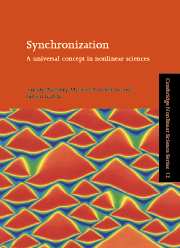Book contents
- Frontmatter
- Contents
- Preface
- Chapter 1 Introduction
- Part I Synchronization without formulae
- Chapter 2 Basic notions: the self-sustained oscillator and its phase
- Chapter 3 Synchronization of a periodic oscillator by external force
- Chapter 4 Synchronization of two and many oscillators
- Chapter 5 Synchronization of chaotic systems
- Chapter 6 Detecting synchronization in experiments
- Part II Phase locking and frequency entrainment
- Part III Synchronization of chaotic systems
- Appendices
- References
- Index
Chapter 5 - Synchronization of chaotic systems
Published online by Cambridge University Press: 06 July 2010
- Frontmatter
- Contents
- Preface
- Chapter 1 Introduction
- Part I Synchronization without formulae
- Chapter 2 Basic notions: the self-sustained oscillator and its phase
- Chapter 3 Synchronization of a periodic oscillator by external force
- Chapter 4 Synchronization of two and many oscillators
- Chapter 5 Synchronization of chaotic systems
- Chapter 6 Detecting synchronization in experiments
- Part II Phase locking and frequency entrainment
- Part III Synchronization of chaotic systems
- Appendices
- References
- Index
Summary
In this chapter we describe synchronization effects in chaotic systems. We start with a brief description of chaotic oscillations in dissipative dynamical systems, emphasizing the properties that are important for the onset of synchronization. Next, we describe different types of synchronization: phase, complete, generalized, etc. In studies of these phenomena computers are widely used, therefore in our illustrations we often use the results of computer simulations, but also show some real experimental data. Whenever possible, we try to underline a similarity to synchronization of periodic oscillations.
Chaotic oscillators
One of the most important achievements of nonlinear dynamics within the last few decades was the discovery of complex, chaotic motion in rather simple oscillators. Now this phenomenon is well-studied and is a subject of undergraduate and high-school courses; nevertheless some introductory presentation is pertinent. The term “chaotic” means that the long-term behavior of a dynamical system cannot be predicted even if there were no natural fluctuations of the system's parameters or influence of a noisy environment. Irregularity and unpredictability result from the internal deterministic dynamics of the system, however contradictory this may sound. If we describe the oscillation of dissipative, self-sustained chaotic systems in the phase space, then we find that it does not correspond to such simple geometrical objects like a limit cycle any more, but rather to complex structures that are called strange attractors (in contrast to limit cycles that are simple attractors).
- Type
- Chapter
- Information
- SynchronizationA Universal Concept in Nonlinear Sciences, pp. 137 - 152Publisher: Cambridge University PressPrint publication year: 2001
- 2
- Cited by

